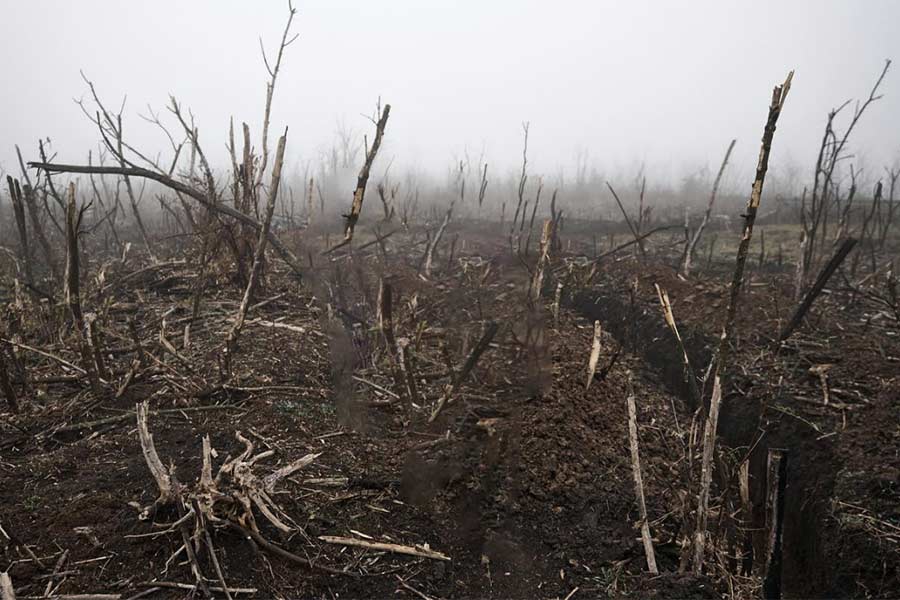How Did the Russian Army Harm Ukraine’s Environment in 2024?
Since the start of Russia’s full-scale invasion of Ukraine, Ecoaction has been monitoring instances of potential environmental damage caused by Russian aggression. Over the course of the war, more than 2,000 cases have been documented, varying in scale and severity—from minor local damage to the complete devastation of natural ecosystems, such as the destruction of the Kakhovka Reservoir Dam by Russian forces.
To highlight these differences, in 2024, we updated our methodology for recording environmental damage and introduced a ranking system from 1 to 3, where 1—a hazardous site was damaged without direct environmental impact, or there is insufficient information about the consequences of the Russian attack; 2—minor and/or local environmental damage has been recorded; 3—significant environmental damage has been confirmed, with sufficient supporting data.

Cases of Potential Environmental Damage Caused by Russian Aggression (1 January – 31 December 2024)
In 2024, Russian forces continued to harm Ukraine’s environment, as evidenced by 450 cases recorded by Ecoaction’s volunteer team. The most severe impact was observed along the frontline and border areas in Sumy, Kharkiv, Donetsk, Dnipropetrovsk, Zaporizhzhia, and Kherson regions, directly linked to active hostilities. In these regions, cases were primarily recorded in the following categories: impact on ecosystems; damage to industrial facilities; damage to energy infrastructure; and nuclear safety (particularly in Zaporizhzhia region, reflecting potential threats at the occupied Zaporizhzhia Nuclear Power Plant, including missile flights over the site and power outages).
Additionally, throughout the year, Russia inflicted environmental damage across the entire territory of Ukraine. Notably, attacks targeted energy facilities, industrial sites, and oil and gas infrastructure. Missile and drone strikes also had a negative impact on Ukraine’s ecosystems.

Cases of Potential Environmental Damage Caused by Russian Aggression (1 January – 31 December 2023)
For comparison, in 2023, 743 cases of potential environmental damage were recorded. The vast majority of cases were recorded along the frontline and in regions subject to heavy shelling from temporarily occupied territories. Most incidents fell into the following categories: impact on the marine ecosystem; damage to oil and gas infrastructure; damage to industrial facilities; impact on ecosystems. The nature of the environmental impact in regions that do not border the Russian Federation was similar to that observed in 2024.

Cases of Potential Environmental Damage (Rank 1) Caused by Russian Aggression (1 January – 31 December 2024)
The majority of recorded cases in 2024 were classified as rank 1, totalling 269 incidents. These involved damage to hazardous sites without a direct environmental impact, or where information about the consequences of Russian attacks remains limited. Examples include: localised fires in ecosystems that were quickly extinguished; damage to industrial facilities with insufficient publicly available information; incidents at the occupied Zaporizhzhia NPP that did not result in the release of radioactive or non-radioactive substances. For comparison, 552 incidents of this rank were recorded in 2023.

Cases of Potential Environmental Damage (Rank 2) Caused by Russian Aggression (1 January – 31 December 2024)
In 2024, a total of 146 rank 2 incidents were recorded, primarily in the following categories: damage to energy infrastructure; damage to industrial facilities; and impact on ecosystems. Each case in this category resulted in significant negative consequences, including fires, emissions of hazardous substances, and the destruction of facilities, leading to environmental pollution. For comparison, 140 incidents of this rank were recorded in 2023, six fewer than in 2024.

Cases of Potential Environmental Damage (Rank 3) Caused by Russian Aggression (1 January – 31 December 2024)
A total of 35 rank 3 cases—describing significant environmental damage with sufficient supporting data—were recorded in 2024. These cases were categorised as follows: impact on ecosystems — 19 cases; damage to energy infrastructure — 9 cases; damage to industrial facilities — 5 cases; livestock waste incidents — 1 case; impact on the marine ecosystem — 1 case. These incidents were geographically dispersed across Ukraine, highlighting the widespread environmental destruction caused by Russian aggression.
For comparison, 49 such cases were recorded in 2023, of which 33 fell under the impact on ecosystems category and occurred on the frontline. Only 6 out of 49 cases were recorded in regions that do not border the frontline or temporarily occupied territories. Among these, three involved the shelling of oil and gas industry facilities.
Next, we will examine specific rank 3 cases recorded in 2024 across different categories. Cases in the impact on ecosystems category vary widely in their environmental impact. For example, Russian forces destroyed over 60,000 hectares of Ukrainian forests within the Sievierodonetsk Forestry and Game Farm. Marine ecosystems were also affected, particularly following the missile attack on the Pivdennyi Port on 19 April, which resulted in a vegetable oil spill contaminating the sea. The environmental damage caused to the marine ecosystem was estimated at nearly UAH 152 million.
Cases in the damage to energy facilities category document Russian attacks on Ukrainian energy infrastructure, including the Dnipro Hydroelectric Power Plant, Burshtyn TPP, Ladyzhyn TPP, Zmiiv TPP, Trypillia TPP, and others. These attacks led to full or partial shutdowns, large-scale fires, and air and nearby areas pollution caused by the combustion of fuels and lubricants. In 2023, there were three such attacks, whereas in 2024, the number rose to nine, as Russian forces increasingly targeted major electricity generation facilities.
Although the damage to industrial facilities and damage to oil and gas industry facilities categories record incidents at different sites, their environmental impact is often similar. For instance, shelling frequently causes fires. One striking example occurred on 22 March 2024, when a Russian attack on an industrial facility in the Odesa region led to the release of 549 tonnes of carbon dioxide into the atmosphere. This case highlights how Russia’s war is also contributing to climate change. All fires caused by hostilities result in additional greenhouse gas emissions. However, other forms of pollution can also occur. For example, on 8 April, a drone strike on an infrastructure facility in the Zviahel community led to a fuel and lubricant leak into the environment. Following a Russian attack on the Ternopil region on 20 August, experts recorded a 4- to 10-fold increase in chlorine levels in the air.

Total Number of Cases of Potential Environmental Damage (2023–2024) The histogram was prepared by Ecoaction volunteer Yelyzaveta Shpak.
In 2024, the Ecoaction volunteer team recorded 450 cases of potential environmental damage caused by Russian aggression—almost one and a half times fewer than in 2023. At the same time, the trend remains unchanged: the vast majority of cases continue to be recorded along the frontline, as in previous years. However, incidents documented in regions further from the frontline often have a higher environmental damage ranking, indicating more severe consequences for the environment.
The number of rank 2 and rank 3 cases—where environmental impact has been clearly documented—is comparable between both years, demonstrating that the environmental consequences of Russian attacks remain persistent despite the ongoing war. The overall decrease in the number of recorded cases is primarily due to a decline in rank 1 incidents—those with potential environmental impact. This reduction may be attributed to methodological improvements for recording rank 1 cases (with better filtering methods applied to the database). On the other hand, the decrease in the number of recorded cases may indeed objectively reflect the fact that many of the objects whose damage falls under recording have already been destroyed earlier, in previous years of full-scale invasion. We should also bear in mind that for security reasons, Ukrainian authorities often do not disclose detailed information about targets hit and their environmental consequences. As a result, the team frequently lacks sufficient data to record cases on the interactive map.
We extend our gratitude to the volunteers who recorded cases of potential environmental damage throughout 2024: Apolinariia Horlova, Anastasiia Moskalenko, Anastasiia Utkina, Anna Bila, Anna Koriahina, Yelyzaveta Shpak, Ivanna Rutkovska, Kateryna Tsymbaliuk, Kseniia Kychka, Mariia Kosovska, Marta Stambulska, Nazar Silko, Nataliia Volyk, Nataliia Dovhaliuk, Snizhana Tereshchenko, Tymur Pliushch, and Tiana Zakharchenko.
This material was created as part of the project Strengthening the EkoNet NGO Network on Climate and Environmental Protection in Eastern Europe and Central Asia, implemented with the support of Austausch e.V. and Bread for the World.




